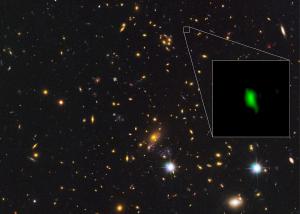Blog
Oxygen on the Edge
13 January 2020
 ALMA (ESO/NAOJ/NRAO), NASA/ESA Hubble Space Telescope, W. Zheng (JHU), M. Postman (STScI), the CLASH Team, Hashimoto et al
ALMA (ESO/NAOJ/NRAO), NASA/ESA Hubble Space Telescope, W. Zheng (JHU), M. Postman (STScI), the CLASH Team, Hashimoto et alIn the study of distant galaxies, one of the ways they are mapped is to observe emission lines from gas and molecules. Most of the gas within a galaxy is hydrogen, but astronomers can gain a better understanding by observing emissions from carbon and oxygen. These elements are only produced in the hearts of stars, so observing them tells us about star-forming regions and the evolution of galaxies.
In recent years astronomers have observed emission lines from single ionized carbon and doubly ionized oxygen in distant galaxies. These can be observed in very distant galaxies. In 2018 oxygen was observed in a galaxy 13.28 billion light-years away. The galactic light came from a time when the universe was only 250 million years old, which tells us that stars formed quite early.1
While observations of doubly ionized oxygen are useful, light from single-ionized oxygen would be easier to interpret. So astronomers have wanted to observe ionized oxygen for some time. Typically this could only be done from space. Our atmosphere absorbs the ultraviolet light from oxygen emission, making it undetectable from the ground.
But with very distant galaxies that’s not the case. The more distant a galaxy, the more its light is shifted to the red end of the spectrum. For galaxies near the edge of the visible universe, the light is so strongly shifted that it becomes near-infrared. This can be observed from the ground in some cases.
Even then, much of the infrared light is absorbed by the water in our atmosphere, so it can only be detected from high elevations under arid conditions. The APEX Telescope meets that condition. Located near ALMA in northern Chile, it is at an elevation of 5100 meters. Recently the APEX team was able to observe ionized oxygen in a galaxy known as G09 83808. Its light traveled for 12.8 billion years to reach us, meaning we see it as the universe was only a billion years old.2
This is only the first detection of ionized oxygen from a distant galaxy. In the future, the APEX team would like to create detailed maps of galaxies using this technique.